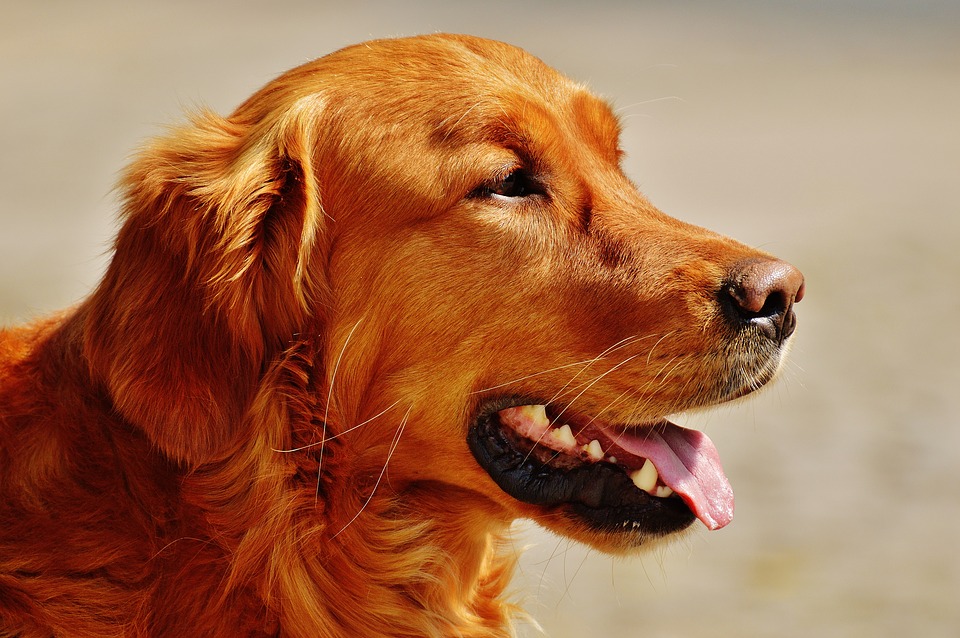The Golden Retriever is one of the most popular dog breeds in the U.S. The friendly, tolerant attitude of the breed makes him a fabulous family pet, and his intelligence makes him a highly capable working dog. This breed excels at retrieving games for hunters, tracking, sniffing out drugs and as therapy and assistance dogs. In addition, Golden Retrievers are natural athletes, and do well in dog sports such as agility and competitive obedience.
Physical Characteristics
Goldens are a symmetrical, powerful, active dog, sound and put together, not clumsy nor long in the leg, while also displaying a kindly expression and possessing a personality that is eager, alert and self-confident. Primarily a hunting dog, this breed should be shown in hard working condition. The overall appearance, balance, gait and purpose is to be given more emphasis than any of his component parts.
Personality
The hallmark of this breed is a sweet, calm nature. It was bred to work with people, and is eager to please his owner. While hard-wired with a good disposition, like all dogs the Golden Retriever must be well-raised and well-trained to make the most of his heritage.
Similar to every other dog, the Golden also needs early socialization — exposure to many different people, sights, sounds and experiences — when they are young. Socialization assists to ensure that your Golden puppy grows up to be a well-rounded dog.
Care
This breed is built for action and loves outdoor romps. If you like to hike or jog, your Golden Retriever will be happy to join you. Also, if you feel like tossing a ball in the backyard, they would be more than happy to join you; true to their name, Goldens love to retrieve. Tiring them out with 20-30 minutes of vigorous exercise twice a day will keep your dog mellow when he is back inside. However, slacking on the activity could lead to behavior problems.
Similar to other retriever breeds, Goldens are naturally “mouthy” and they are happiest when they have something to carry in their mouths: a ball, soft toy, newspaper, or best of all, a smelly sock.
Raising a Golden puppy requires you to take special care, as the dogs grow extremely rapidly between the age of four and seven months, which makes them susceptible to bone disorders. Don’t let your Golden pup run and play on very hard surfaces such as pavement until he is at least two years old and his joints are fully formed. Normal play on grass is fine, and so are puppy agility classes.
Health
Like all breeds, there may be some health issues, such as hip and elbow dysplasia, eye disease and cardiac disease. While some dogs may be faced with these health challenges in their lives, the majority of Golden Retrievers are healthy dogs.
In Goldens, expect to see health clearances from the Orthopedic Foundation for Animals (OFA) for hip dysplasia (with a score of fair or better), elbow dysplasia, hypothryoidism and von Willebrand’s disease; from Auburn University for thrombopathia; and from the Canine Eye Registry Foundation (CERF) certifying that eyes are normal. These health clearances can be confirmed by checking the OFA website.
History
For many years, there was a legend that Golden Retrievers were descended from Russian sheepdogs bought from a circus. In fact, the breed was developed in Scotland, at the highland estate of Sir Dudley Majoribanks, later known as Lord Tweedmouth. Like many gentry of his day, Tweedmouth bred animals of all kinds, trying to perfect different breeds. His breeding records from 1835 to 1890 show what he was aiming for with the Golden: A talented retriever — Tweedmouth was an ardent waterfowl hunter — with an excellent nose, who would be more attentive to his human hunting companion than the setters and spaniels used at the time for retrieving. Tweedmouth also wanted the dog to be loyal and even-tempered in the home.
Nous was taking home to Scotland by Tweedmouth, and in 1869 and 1871, was bred with Belle, a Tweed Water Spaniel. Now extinct, Tweed Water Spaniels were known for being eager retrievers in the hunting field, and exceptionally calm and loyal in the home — characteristics you will find in today’s Golden Retrievers. The descendants of Nous and Belle were bred with Wavy- and Flat-coated retrievers, another Tweed Water Spaniel and a red setter. Tweedmouth kept mostly the yellow puppies to continue his breeding program, and gave others away to friends and relatives.
Not shockingly, Tweedmouth’s breed first attracted attention for their skills in the hunting field. Don of Gerwyn, a liver-coated descendant of one of Tweedmouth’s dogs, who won the International Gundog League trial in 1904, was one of the most well-known.
The Golden Retriever was officially recognized as a district breed in 1911 by the Kennel Club in England. The American Kennel Club recognized the breed in 1932. Today, this breed is the second most popular breed in the U.S.
For more information the Golden Retriever or other dog breeds, don’t hesitate to contact us here at All Pets Veterinary Medical Center with the link below!
















